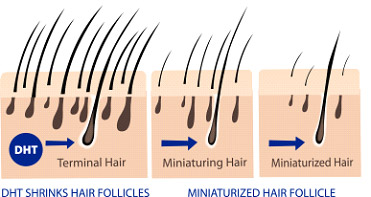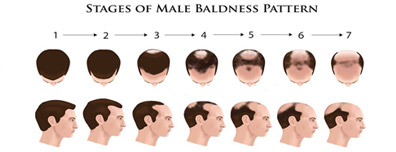You are here : Home / Hair Loss / Male Hair Loss
Hair Loss is a very common problem affecting a majority of men and women. About 85% of men undergo some sort of major hair loss before reaching the age of 50. Nowadays with more stressful lifestyles, eating habits and environmental factors, men as young as 20 years have reported hair loss problems.
Men are more likely to experience hair loss than women. Most common type of hair loss among men is due to Androgenetic alopecia or common male pattern baldness (MPB). Androgenetic alopecia accounts for more than 95% of all hair loss cases. 25% of all Androgenetic alopecia cases occur before the age of 21 in men.
Adrogenetic alopecia is a more medical term for Male or Female Pattern Baldness. While pattern of hair loss in men and women may differ, the underlying cause is generally genetic. In India, more than 10 million cases of pattern hair loss are reported every year.

Hair loss is devastating for hair loss sufferer and it affects every aspect of their social and personal life. Initial stages involve finding out why the hair loss is happening and what is causing it. Then in later stages, stress and unhappiness pervades as hair loss is seen as a disease which destroys one’s confidence and youth.
At Athena HairNow we deeply emphathize with these issues, understand what is going on through a patient’s mind and recognize how devastating this problem could be for especially young men. Athena HairNow, Chandigarh’s top hair transplant clinic, run by expert Dermatologist Dr. Harmandeep Sidhu and her experienced and trained staff, have performed over 1100+ hair transplant surgeries with happy and satisfied patients.
Word Alopecia just means “hair loss”. It could be any type of hair loss. Androgenetic is hair loss that occurs due to an underlying susceptibility of hair follicles to androgenic miniaturization. Androgenetic alopecia accounts for more than 95% of all hair loss cases among men. While there are many possible reasons for male hair loss including reaction to a medication, poor diet, traction (with turbans and headwear tied too tight over a longer periods), stress, etc., these cases only account for 5% of all hair loss patients.
Primary reason is the genetic sensitivity of a person towards DHT (Dihydrotestosterone). DHT is a by-product of testosterone. Testosterone (hormone that makes you male) converts to DHT with the help of an enzyme Type II 5-alpha-reductace. DHT attacks the hair follicles that are genetically susceptible to shrinkage from this hormone.

Male Pattern Baldness is related to your genes and male sex hormones. Male Hair loss starts with receding hairliness and thinning on the crown. Given below are different stages of male hair loss.


Hair Transplant is curently the only permanent solution with no side effects. Medications can help slow down the process of hair loss but you cannot regrow follicles which have died. With hair transplant you can regrow hair on bald spots. With hair transplant, you can restore your natural look and regain the hairline and crown.
By taking Propecia some patients undergo some side effects like loss of libido. Treating hair loss with only medications and no hair transplant is also expensive over the longer term. Generally hair transplant patients take medications to prevent further hair loss.
Finasteride has been FDA approved to treat male pattern baldness in most men who use it and has been proven to slow hair loss in men by decreasing DHT by 60 percent.
Minoxidil, the first FDA approved drug for male pattern baldness, provides a temporary solution to male hair loss. If Finasteride doesn’t help with hair growth Minoxidil may be your solution.



+91-98882-78831
+91 172-5084614
before

after

before

after
